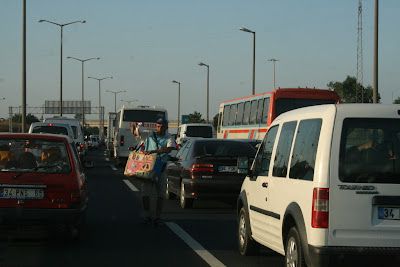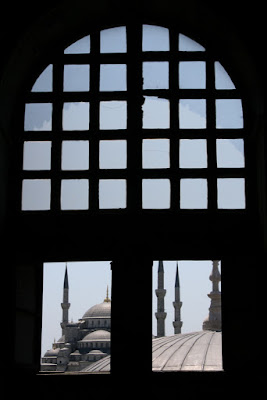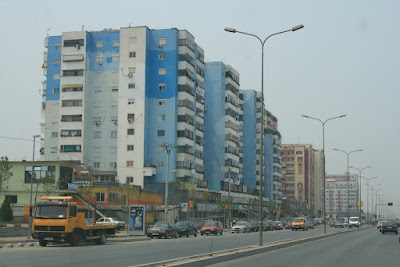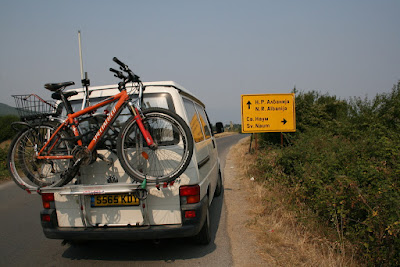Our eastern most point of our journey was quickly appearing before us as the sunset behind us. We'd managed to get here without hardly any trouble having expected all kind of delays at the Bulgarian/Turkish border. But they weren't to be and we even met some Polish travellers who were also heading our way. En route we discovered that they were also heading to the same campground on the edge of Istanbul.
 Istanbul's approaching suburbs
Istanbul's approaching suburbs
Now that we were arriving the traffic had quickly built up and we found that we were not the only ones heading this way for the holidays. At times the motorway came to an abrupt standstill, without any apparent reason, quickly followed by the appearance of icecream salesmen! It seems that they'd stalled the traffic in order to get extra sales in, bizarre!
 Traffic jams? No just a dedicated team of icecream salesmen on the Motorway!
Traffic jams? No just a dedicated team of icecream salesmen on the Motorway!Many other European plated cars were also headed this way. On closer inspection it was clear that they were merely returning to their homeland for the holidays. Turkey may not yet be part of the EU but looking at the variety of plates, Austrian, Swiss, plenty of Dutch and German too, they have already won the freedom of travel and judging by the quality of the cars doing pretty well for themselves too!
Luckily our sat nav TomTom appeared to have a map of Istanbul so we were able to pinpoint where the camping was and focus on the mad hat driving rather than worrying about directions too. Or so we thought! The traffic was thick but TomTom never missed a beat and we weaved our way through a spaghetti of on and off ramps on to various ring motorways. We'd compared notes on Istanbul with our Polish travelling companions and there was some debate as to how many people lived here, our guide said 16 million theirs 12, in actual fact we discovered that it's actually nearing 20 million people!
Before we knew it we'd landed in the middle of downtown Istanbul, I was adamant TomTom was right but when the next turn off would have taken us accross the Bosphorous then something must be wrong, we should have been on the other side of Istanbul, plus the insurance only covers us in 'European' Turkey. After nearly driving past the Blue Mosque, we made our way to where the camping should have been. Unfortunately on arrival we found an abandonded camping ground and gas station. Luckily a few other campervans were there and the gas station was selling its parking services. It seems that the government had closed down and bulldozed every campground in Istanbul due to 'problems' they had had. No one could quite explain what the problems were but many of the other places closed earlier in the year were teahouses built illegaly along the water front. It all had happened quite recently so one would have to speculate that this may have something to do with the forthcoming election who's banners we'd seen all through town.
The last time I'd vistited Istanbul was more than 10 years ago on a foray into the Middle East with my sister Julia and friend Tane. Tane and I hadn't seen each other for a while so spent much our time here in the Orient hostel bar drinking 'wodka' and orange. Much to Julia's dismay we spent the next days well hungover not seeing as much as we should. Tane and I were backpacking but Juila was only here for a week.
 The cooling spray of water fountains outside the Aya Sofya
The cooling spray of water fountains outside the Aya Sofya
I could vaguely recognise the layout of the city but it had certainly moved on in leaps and bounds. The boulevards were all well kept, trams very modern and efficient and as always the Turkish people were welcoming and friendly. One evening we even went backto the Orient hostel below the Aya Sofya. This area had changed beyond recognition, the sleepy little back alley was now bustling with flashy resuraunts and the hostels had become more like hotels. One thing that was still there was the dilligent baker who sold bread till the wee hours of the night at around 10 cents a substantial loaf.
The Blue Mosque was wonderful to see and the central square between it and the Aya Sofya, a favorite spot for the classic postcard pictures of them both. as below ;)
 The famous blue mosque
The famous blue mosque
Surprisingly, the Mosque doesn't seem blue, but closer inspection reveals that the interior upper terrace is covered in blue tilings, which is where it got it's name from.
 Northern entrance to the Blue Mosque
Northern entrance to the Blue Mosque
It's a great place to hide from the heat, especially when it's been pushing beyond 30 degrees, and also to contemplate the history of Istanbul, which really does define the term 'east meets west' so well.
 Appropriately dressed for the occasion
Appropriately dressed for the occasion
 Amazing interior designs
Amazing interior designs
 Sun setting on the spires of the Blue Mosque
Sun setting on the spires of the Blue Mosque
No one can deny that back in the 1600s when Sultan Ahmet ordered a mosque to be built that would rival the Aya Sofya in terms of beauty and grandeur, that he really did succeed. But given that the Agia Sofia was built 1000 years prior, back around 500ad when the Roman Empire had recently split in two, it's a very impressive building and remained the largest Christian church in the world for over 1000 years.
The Aya Sofya wasn't quite as calming as the Blue Mosque, with it being over run by tourists in a way that mosques never would allow. Mustafa Kemal Ataturk,the much revered reformer of the Turkish republic, turned this once church, then mosque into a museum as part of his secularisation of Turkey in the 1930's. This, along with the banning of the Fez and of the Turkish script alphabet (in favour of a latinised version) were all steps that were intended to bring the whole of Turkey closer to the west.
 Modern art inside the Aya Sofya
Modern art inside the Aya Sofya
 The grand entrance to the Sofya
The grand entrance to the Sofya
 A window to the West looking out at the Blue Mosque
A window to the West looking out at the Blue MosqueWe wandered around the city for several days taking in all the sights and sounds, getting a long overdue shave, and down to the riverside for lunch at the local snack bars. We cleverly left the grand bazaar to the end of each day, knowing that we would not be leaving empty handed.
 Inside the cooling shade of the Grand Bazaar
Inside the cooling shade of the Grand Bazaar
 I give you special price!
I give you special price!
The experience of haggling with the stall holders is always a laugh and we met some real characters, many were very interested to hear our opinons on Turkey after discovering this was our fourth trip to Turkey. After one intense discussion with an interested local, I even managed to seal his voting decision for the coming weekend.
 Not quite sold on the hat, after all aren't they illegal?
Not quite sold on the hat, after all aren't they illegal?
After several nights risking the 'camping that wasn't' we drove in to spend a morning in the city, only to find ourselves ushered into a carpark directly beneath the Blue Mosque. We'd been in that area for a few days now and a local had recognised us, and introduced us to the lady who owned the parking, who in turn allowed us to stay over night and even offered the use of her shower too! Very typical Turkish hospitality - at its best! It turned out to be the best camping yet and with an abundance of Turkish baths in town what more would we need?
 Serious game of Tavli on the Bosphoros water front
Serious game of Tavli on the Bosphoros water front
In all the stay was fabulous, Istanbul firmly became Sharon's favourite city ever, and it was sad to say goodbye to both the city and our local 'neighbourhood'. Luckily we weren't leaving Turkey just yet!
EH
 No ute? No problem!
No ute? No problem! Learning to drive in a stolen Mercedes so you can be confident in your own stolen Mercedes
Learning to drive in a stolen Mercedes so you can be confident in your own stolen Mercedes Hot Hot Hot!
Hot Hot Hot! Hot in more ways than one
Hot in more ways than one























































